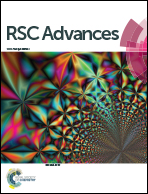Development of photoactivable glycerol-based coatings containing quercetin for antibacterial applications†
Abstract
The development of new antibacterial coatings (against Escherichia coli and Staphylococcus aureus) using a natural dye, quercetin, according to a green chemistry process was investigated. Quercetin was used as both a photosensitizer and antibacterial agent. The synthesized material was developed according to a cationic photopolymerization process under light irradiation. The photosensitizing mechanism involving quercetin and an iodonium-based cationic photoinitiator was described for the first time according to steady state photolysis and fluorescence experiments. The resulting coatings showed excellent adhesion on a stainless steel plate as demonstrated by nanoindentation and scratch tests, with a high thermal stability up to 375 °C. Finally, a primary investigation was conducted to assess the antibacterial properties of the glycerol-derived coatings against Escherichia coli and Staphylococcus aureus under light illumination. Electron paramagnetic resonance spectroscopy confirmed the generation of reactive oxygen species, such as singlet oxygen, which is responsible for inhibiting bacteria proliferation.


 Please wait while we load your content...
Please wait while we load your content...